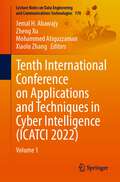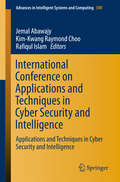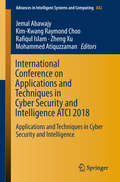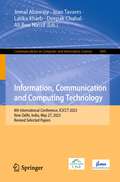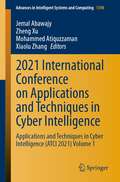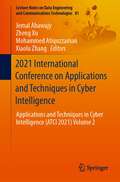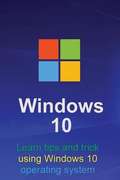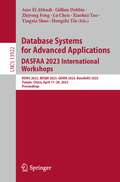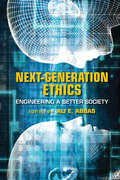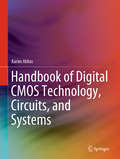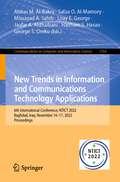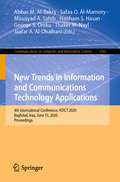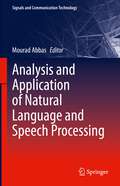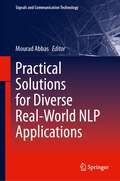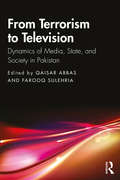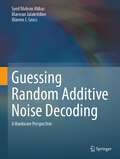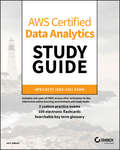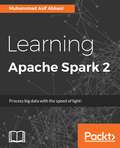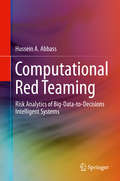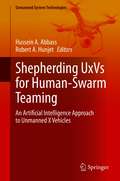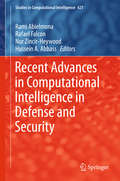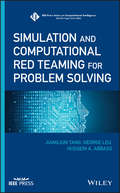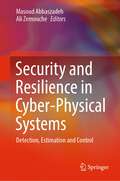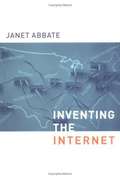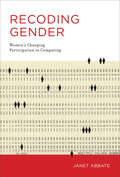- Table View
- List View
Tenth International Conference on Applications and Techniques in Cyber Intelligence: Volume 1 (Lecture Notes on Data Engineering and Communications Technologies #170)
by Jemal H. Abawajy Xiaolu Zhang Mohammed Atiquzzaman Zheng XuThis book presents innovative ideas, cutting-edge findings, and novel techniques, methods, and applications in a broad range of cybersecurity and cyberthreat intelligence areas. As our society becomes smarter, there is a corresponding need to secure our cyberfuture. The book describes approaches and findings that are of interest to business professionals and governments seeking to secure our data and underpin infrastructures, as well as to individual users.
International Conference on Applications and Techniques in Cyber Security and Intelligence
by Jemal Abawajy Kim-Kwang Raymond Choo Rafiqul IslamThis book presents the outcomes of the 2017 International Conference on Applications and Techniques in Cyber Security and Intelligence, which focused on all aspects of techniques and applications in cyber and electronic security and intelligence research. The conference provides a forum for presenting and discussing innovative ideas, cutting-edge research findings, and novel techniques, methods and applications on all aspects of cyber and electronic security and intelligence.
International Conference on Applications and Techniques in Cyber Security and Intelligence ATCI 2018: Applications And Techniques In Cyber Security And Intelligence (Advances In Intelligent Systems and Computing #842)
by Jemal Abawajy Kim-Kwang Raymond Choo Rafiqul Islam Zheng Xu Mohammed AtiquzzamanThe book highlights innovative ideas, cutting-edge findings, and novel techniques, methods and applications touching on all aspects of technology and intelligence in smart city management and services. Above all, it explores developments and applications that are of practical use and value for Cyber Intelligence-related methods, which are frequently used in the context of city management and services.
Information, Communication and Computing Technology: 8th International Conference, ICICCT 2023, New Delhi, India, May 27, 2023, Revised Selected Papers (Communications in Computer and Information Science #1841)
by Jemal Abawajy Joao Tavares Latika Kharb Deepak Chahal Ali Bou NassifThis book constitutes the refereed proceedings of the 8th International Conference on Information, Communication and Computing Technology, ICICCT 2023, held in New Delhi, India, during May 27, 2023.The 14 full papers included in this book were carefully reviewed and selected from 60 submissions. They were organized in topical sections as follows: global platform for researchers, scientists and practitioners from both academia and industry to present their research and development activities in all the aspects of Pattern Recognition and computational Intelligence techniques.
2021 International Conference on Applications and Techniques in Cyber Intelligence: Applications and Techniques in Cyber Intelligence (ATCI 2021) Volume 1 (Advances in Intelligent Systems and Computing #1398)
by Jemal Abawajy Zheng Xu Mohammed Atiquzzaman Xiaolu ZhangThis book presents innovative ideas, cutting-edge findings, and novel techniques, methods, and applications in a broad range of cybersecurity and cyberthreat intelligence areas. As our society becomes smarter, there is a corresponding need to secure our cyberfuture. The book describes approaches and findings that are of interest to business professionals and governments seeking to secure our data and underpin infrastructures, as well as to individual users.
2021 International Conference on Applications and Techniques in Cyber Intelligence: Applications and Techniques in Cyber Intelligence (ATCI 2021) Volume 2 (Lecture Notes on Data Engineering and Communications Technologies #81)
by Jemal Abawajy Zheng Xu Mohammed Atiquzzaman Xiaolu ZhangThis book presents innovative ideas, cutting-edge findings, and novel techniques, methods, and applications in a broad range of cybersecurity and cyberthreat intelligence areas. As our society becomes smarter, there is a corresponding need to secure our cyberfuture. The book describes approaches and findings that are of interest to business professionals and governments seeking to secure our data and underpin infrastructures, as well as to individual users. 1. Highlights recent applications and techniques in cyber intelligence2. Includes the proceedings of the 2021 International Conference on Applications and Techniques in Cyber Intelligence (ATCI 2021) 3. Presents a broad range of scientific research on cyber intelligence
Windows 10: Learn Tips And Tricks On Using Windows 10 Operating System
by Blerton AbaziWindows 10 Learn tips and trick on using Windows 10 operating system
Database Systems for Advanced Applications. DASFAA 2023 International Workshops: BDMS 2023, BDQM 2023, GDMA 2023, BundleRS 2023, Tianjin, China, April 17-20, 2023, Proceedings (Lecture Notes in Computer Science #13922)
by Amr El Abbadi Gillian Dobbie Zhiyong Feng Lu Chen Xiaohui Tao Yingxia Shao Hongzhi YinThis volume constitutes the papers of several workshops which were held in conjunction with the 28th International Conference on Database Systems for Advanced Applications, DASFAA 2023, held in Tanjin, China, in April 2023. The 23 revised full papers presented in this book were carefully reviewed and selected from 40 submissions. DASFAA 2023 presents the following four workshops: 9th International Workshop on Big Data Management and Service (BDMS 2023), 8th International Workshop on Big Data Quality Management (BDQM 2023); 7th International Workshop on Graph Data Management and Analysis (GDMA 2023); 1st International Workshop on Bundle-based Recommendation Systems (BundleRS 2023).
Next-Generation Ethics: Engineering a Better Society
by Ali E. AbbasMany of the significant developments of our era have resulted from advances in technology, including the design of large-scale systems; advances in medicine, manufacturing, and artificial intelligence; the role of social media in influencing behaviour and toppling governments; and the surge of online transactions that are replacing human face-to-face interactions. These advances have given rise to new kinds of ethical concerns around the uses (and misuses) of technology. This collection of essays by prominent academics and technology leaders covers important ethical questions arising in modern industry, offering guidance on how to approach these dilemmas. Chapters discuss what we can learn from the ethical lapses of #MeToo, Volkswagen, and Cambridge Analytica, and highlight the common need across all applications for sound decision-making and understanding the implications for stakeholders. Technologists and general readers with no formal ethics training and specialists exploring technological applications to the field of ethics will benefit from this overview.
Handbook of Digital CMOS Technology, Circuits, and Systems
by Karim AbbasThis book provides a comprehensive reference for everything that has to do with digital circuits. The author focuses equally on all levels of abstraction. He tells a bottom-up story from the physics level to the finished product level. The aim is to provide a full account of the experience of designing, fabricating, understanding, and testing a microchip. The content is structured to be very accessible and self-contained, allowing readers with diverse backgrounds to read as much or as little of the book as needed. Beyond a basic foundation of mathematics and physics, the book makes no assumptions about prior knowledge. This allows someone new to the field to read the book from the beginning. It also means that someone using the book as a reference will be able to answer their questions without referring to any external sources.
New Trends in Information and Communications Technology Applications: 6th International Conference, NTICT 2022, Baghdad, Iraq, November 16–17, 2022, Proceedings (Communications in Computer and Information Science #1764)
by Abbas M. Al-Bakry Safaa O. Al-Mamory Mouayad A. Sahib Loay E. George Jaafar A. Aldhaibani Haitham S. Hasan George S. OrekuThis book constitutes the refereed proceedings of the 6th International Conference on New Trends in Information and Communications Technology Applications, NTICT 2022, held in Baghdad, Iraq, during November 16–17, 2022. The 14 full papers included in this book were carefully reviewed and selected from 53 submissions. They were organized in topical sections as follows: computing methodologies; information systems; network; security and privacy.
New Trends in Information and Communications Technology Applications: 4th International Conference, NTICT 2020, Baghdad, Iraq, June 15, 2020, Proceedings (Communications in Computer and Information Science #1183)
by Abbas M. Al-Bakry Safaa O. Al-Mamory Mouayad A. Sahib Haitham S. Hasan George S. Oreku Thaker M. Nayl Jaafar A. Al-DhaibaniThis book constitutes refereed proceedings of the 4th International Conference on New Trends in Information and Communications Technology Applications, NTICT 2020, held on June 15, 2020. The NTICT conference was planned to take place in Baghdad on March 11-12, 2019, but due to the COVID-19 pandemic the conference has been postponed on June 15, 2020 and moved to the virtual format.The 15 full papers and 3 short papers presented were thoroughly reviewed and selected from 90 qualified submissions. The volume presents the latest research results in such areas as network protocols, overlay and other logical network structures, wireless access networks, computer vision, machine learning, artificial Intelligence, data mining, control methods.
Analysis and Application of Natural Language and Speech Processing (Signals and Communication Technology)
by Mourad AbbasThis book presents recent advances in NLP and speech technology, a topic attracting increasing interest in a variety of fields through its myriad applications, such as the demand for speech guided touchless technology during the Covid-19 pandemic. The authors present results of recent experimental research that provides contributions and solutions to different issues related to speech technology and speech in industry. Technologies include natural language processing, automatic speech recognition (for under-resourced dialects) and speech synthesis that are useful for applications such as intelligent virtual assistants, among others. Applications cover areas such as sentiment analysis and opinion mining, Arabic named entity recognition, and language modelling. This book is relevant for anyone interested in the latest in language and speech technology.
Practical Solutions for Diverse Real-World NLP Applications (Signals and Communication Technology)
by Mourad AbbasThis book unveils the most advanced techniques and innovative applications in the natural language processing (NLP) field. It uncovers the secrets to enhancing language understanding, and presents practical solutions to different NLP tasks, as text augmentation, paraphrase generation, and restoring spaces and punctuation in multiple languages. It unlocks the potential of hierarchical multi-task learning for cross-lingual phoneme recognition, and allows readers to explore more real-world applications such as error correction, aggregating industrial security findings as well as predicting music emotion values from social media conversations. "Practical Solutions for Diverse Real-World NLP Applications" is the suitable guidebook for researchers, students, and practitioners as it paves the way for them by delivering invaluable insights and knowledge.
From Terrorism to Television: Dynamics of Media, State, and Society in Pakistan
by Qaisar AbbasThis book unpacks the media dynamics within the socio-cultural, political, and economic context of Pakistan. It provides an in-depth, critical, and scholarly discussion of contemporary issues such as media, state, and democracy in Pakistan; freedom of expression in Pakistani journalism; Balochistan as a blind spot in mainstream newspapers; media control by state institutions; women and media discourses; TV talk shows and coverage of Kashmir; feminist narrative and media images of Malala Yousufzai and Mukhtaran Mai; jihad on screen; and Osama bin Laden’s death on screen, to understand the relation between media and terrorism. The book covers diverse media types including TV, radio, newspapers, print media, films, documentary, stage performance, and social media. Detailed, interdisciplinary, analytical, and with original perspectives from journalists as well as academics, this volume will be useful to scholars and researchers of media studies, Pakistan studies, politics and international affairs, military and terrorism studies, journalism and communication studies, and South Asian studies. It will also interest general readers, policy makers, and those interested in global journalism, mass media, and freedom of expression.
Guessing Random Additive Noise Decoding: A Hardware Perspective
by Syed Mohsin Abbas Marwan Jalaleddine Warren J. GrossThis book gives a detailed overview of a universal Maximum Likelihood (ML) decoding technique, known as Guessing Random Additive Noise Decoding (GRAND), has been introduced for short-length and high-rate linear block codes. The interest in short channel codes and the corresponding ML decoding algorithms has recently been reignited in both industry and academia due to emergence of applications with strict reliability and ultra-low latency requirements . A few of these applications include Machine-to-Machine (M2M) communication, augmented and virtual Reality, Intelligent Transportation Systems (ITS), the Internet of Things (IoTs), and Ultra-Reliable and Low Latency Communications (URLLC), which is an important use case for the 5G-NR standard. GRAND features both soft-input and hard-input variants. Moreover, there are traditional GRAND variants that can be used with any communication channel, and specialized GRAND variants that are developed for a specific communication channel. This book presents a detailed overview of these GRAND variants and their hardware architectures. The book is structured into four parts. Part 1 introduces linear block codes and the GRAND algorithm. Part 2 discusses the hardware architecture for traditional GRAND variants that can be applied to any underlying communication channel. Part 3 describes the hardware architectures for specialized GRAND variants developed for specific communication channels. Lastly, Part 4 provides an overview of recently proposed GRAND variants and their unique applications.This book is ideal for researchers or engineers looking to implement high-throughput and energy-efficient hardware for GRAND, as well as seasoned academics and graduate students interested in the topic of VLSI hardware architectures. Additionally, it can serve as reading material in graduate courses covering modern error correcting codes and Maximum Likelihood decoding for short codes.
AWS Certified Data Analytics Study Guide: Specialty (DAS-C01) Exam
by Asif AbbasiMove your career forward with AWS certification! Prepare for the AWS Certified Data Analytics Specialty Exam with this thorough study guide This comprehensive study guide will help assess your technical skills and prepare for the updated AWS Certified Data Analytics exam. Earning this AWS certification will confirm your expertise in designing and implementing AWS services to derive value from data. The AWS Certified Data Analytics Study Guide: Specialty (DAS-C01) Exam is designed for business analysts and IT professionals who perform complex Big Data analyses. This AWS Specialty Exam guide gets you ready for certification testing with expert content, real-world knowledge, key exam concepts, and topic reviews. Gain confidence by studying the subject areas and working through the practice questions. Big data concepts covered in the guide include: Collection Storage Processing Analysis Visualization Data security AWS certifications allow professionals to demonstrate skills related to leading Amazon Web Services technology. The AWS Certified Data Analytics Specialty (DAS-C01) Exam specifically evaluates your ability to design and maintain Big Data, leverage tools to automate data analysis, and implement AWS Big Data services according to architectural best practices. An exam study guide can help you feel more prepared about taking an AWS certification test and advancing your professional career. In addition to the guide’s content, you’ll have access to an online learning environment and test bank that offers practice exams, a glossary, and electronic flashcards.
Learning Apache Spark 2
by Muhammad Asif AbbasiLearn about the fastest-growing open source project in the world, and find out how it revolutionizes big data analytics About This Book • Exclusive guide that covers how to get up and running with fast data processing using Apache Spark • Explore and exploit various possibilities with Apache Spark using real-world use cases in this book • Want to perform efficient data processing at real time? This book will be your one-stop solution. Who This Book Is For This guide appeals to big data engineers, analysts, architects, software engineers, even technical managers who need to perform efficient data processing on Hadoop at real time. Basic familiarity with Java or Scala will be helpful. The assumption is that readers will be from a mixed background, but would be typically people with background in engineering/data science with no prior Spark experience and want to understand how Spark can help them on their analytics journey. What You Will Learn • Get an overview of big data analytics and its importance for organizations and data professionals • Delve into Spark to see how it is different from existing processing platforms • Understand the intricacies of various file formats, and how to process them with Apache Spark. • Realize how to deploy Spark with YARN, MESOS or a Stand-alone cluster manager. • Learn the concepts of Spark SQL, SchemaRDD, Caching and working with Hive and Parquet file formats • Understand the architecture of Spark MLLib while discussing some of the off-the-shelf algorithms that come with Spark. • Introduce yourself to the deployment and usage of SparkR. • Walk through the importance of Graph computation and the graph processing systems available in the market • Check the real world example of Spark by building a recommendation engine with Spark using ALS. • Use a Telco data set, to predict customer churn using Random Forests. In Detail Spark juggernaut keeps on rolling and getting more and more momentum each day. Spark provides key capabilities in the form of Spark SQL, Spark Streaming, Spark ML and Graph X all accessible via Java, Scala, Python and R. Deploying the key capabilities is crucial whether it is on a Standalone framework or as a part of existing Hadoop installation and configuring with Yarn and Mesos. The next part of the journey after installation is using key components, APIs, Clustering, machine learning APIs, data pipelines, parallel programming. It is important to understand why each framework component is key, how widely it is being used, its stability and pertinent use cases. Once we understand the individual components, we will take a couple of real life advanced analytics examples such as 'Building a Recommendation system', 'Predicting customer churn' and so on. The objective of these real life examples is to give the reader confidence of using Spark for real-world problems. Style and approach With the help of practical examples and real-world use cases, this guide will take you from scratch to building efficient data applications using Apache Spark. You will learn all about this excellent data processing engine in a step-by-step manner, taking one aspect of it at a time. This highly practical guide will include how to work with data pipelines, dataframes, clustering, SparkSQL, parallel programming, and such insightful topics with the help of real-world use cases.
Computational Red Teaming: Risk Analytics of Big-Data-to-Decisions Intelligent Systems
by Hussein A. AbbassWritten to bridge the information needs of management and computational scientists, this book presents the first comprehensive treatment of Computational Red Teaming (CRT). The author describes an analytics environment that blends human reasoning and computational modeling to design risk-aware and evidence-based smart decision making systems. He presents the Shadow CRT Machine, which shadows the operations of an actual system to think with decision makers, challenge threats, and design remedies. This is the first book to generalize red teaming (RT) outside the military and security domains and it offers coverage of RT principles, practical and ethical guidelines. The author utilizes Gilbert's principles for introducing a science. Simplicity: where the book follows a special style to make it accessible to a wide range of readers. Coherence: where only necessary elements from experimentation, optimization, simulation, data mining, big data, cognitive information processing, and system thinking are blended together systematically to present CRT as the science of Risk Analytics and Challenge Analytics. Utility: where the author draws on a wide range of examples, ranging from job interviews to Cyber operations, before presenting three case studies from air traffic control technologies, human behavior, and complex socio-technical systems involving real-time mining and integration of human brain data in the decision making environment.
Shepherding UxVs for Human-Swarm Teaming: An Artificial Intelligence Approach to Unmanned X Vehicles (Unmanned System Technologies)
by Hussein A. Abbass Robert A. HunjetThis book draws inspiration from natural shepherding, whereby a farmer utilizes sheepdogs to herd sheep, to inspire a scalable and inherently human friendly approach to swarm control. The book discusses advanced artificial intelligence (AI) approaches needed to design smart robotic shepherding agents capable of controlling biological swarms or robotic swarms of unmanned vehicles. These smart shepherding agents are described with the techniques applicable to the control of Unmanned X Vehicles (UxVs) including air (unmanned aerial vehicles or UAVs), ground (unmanned ground vehicles or UGVs), underwater (unmanned underwater vehicles or UUVs), and on the surface of water (unmanned surface vehicles or USVs). This book proposes how smart ‘shepherds’ could be designed and used to guide a swarm of UxVs to achieve a goal while ameliorating typical communication bandwidth issues that arise in the control of multi agent systems. The book covers a wide range of topics ranging from the design of deep reinforcement learning models for shepherding a swarm, transparency in swarm guidance, and ontology-guided learning, to the design of smart swarm guidance methods for shepherding with UGVs and UAVs. The book extends the discussion to human-swarm teaming by looking into the real-time analysis of human data during human-swarm interaction, the concept of trust for human-swarm teaming, and the design of activity recognition systems for shepherding.Presents a comprehensive look at human-swarm teaming;Tackles artificial intelligence techniques for swarm guidance;Provides artificial intelligence techniques for real-time human performance analysis.
Recent Advances in Computational Intelligence in Defense and Security
by Hussein A. Abbass Nur Zincir-Heywood Rafael Falcon Rami AbielmonaThis volume is an initiative undertaken by the IEEE ComputationalIntelligence Society's Task Force on Security, Surveillance and Defense to consolidateand disseminate the role of CI techniques in the design, development anddeployment of security and defense solutions. Applications range from thedetection of buried explosive hazards in a battlefield to the control ofunmanned underwater vehicles, the delivery of superior video analytics forprotecting critical infrastructures or the development of stronger intrusiondetection systems and the design of military surveillance networks. Defensescientists, industry experts, academicians and practitioners alike will allbenefit from the wide spectrum of successful applications compiled in thisvolume. Senior undergraduate or graduate students may also discover unchartedterritory for their own research endeavors.
Simulation and Computational Red Teaming for Problem Solving (IEEE Press Series on Computational Intelligence)
by Hussein Abbass Jiangjun Tang George LeuAn authoritative guide to computer simulation grounded in a multi-disciplinary approach for solving complex problems Simulation and Computational Red Teaming for Problem Solving offers a review of computer simulation that is grounded in a multi-disciplinary approach. The authors present the theoretical foundations of simulation and modeling paradigms from the perspective of an analyst. The book provides the fundamental background information needed for designing and developing consistent and useful simulations. In addition to this basic information, the authors explore several advanced topics. The book’s advanced topics demonstrate how modern artificial intelligence and computational intelligence concepts and techniques can be combined with various simulation paradigms for solving complex and critical problems. Authors examine the concept of Computational Red Teaming to reveal how the combined fundamentals and advanced techniques are used successfully for solving and testing complex real-world problems. This important book: • Demonstrates how computer simulation and Computational Red Teaming support each other for solving complex problems • Describes the main approaches to modeling real-world phenomena and embedding these models into computer simulations • Explores how a number of advanced artificial intelligence and computational intelligence concepts are used in conjunction with the fundamental aspects of simulation Written for researchers and students in the computational modelling and data analysis fields, Simulation and Computational Red Teaming for Problem Solving covers the foundation and the standard elements of the process of building a simulation and explores the simulation topic with a modern research approach.
Security and Resilience in Cyber-Physical Systems: Detection, Estimation and Control
by Masoud Abbaszadeh Ali ZemoucheThis book discusses the latest advances in cyber-physical security and resilience of cyber-physical systems, including cyber-attack detection, isolation, situation awareness, resilient estimation and resilient control under attack. It presents both theoretical results and important applications of the methods. Security and Resilience in Cyber-Physical Systems begins by introducing the topic of cyber-physical security, covering state-of-the-art trends in both theory and applications, as well as some of the emerging methodologies and future directions for research. It then moves on to detail theoretical methods of attack detection, resilient estimation and control within cyber-physical systems, before discussing their various applications, such as power generation and distribution, autonomous systems, wireless communication networks and chemical plants. Focusing on the detection of and accommodation to cyber-attacks on cyber-physical systems, and including both estimation and artificial-intelligence-based methods, this book will be of interest to researchers, engineers and graduate students within the fields of cyber-physical security and resilient control.
Inventing the Internet
by Janet AbbateSince the late 1960s the Internet has grown from a single experimental network serving a dozen sites in the United States to a network of networks linking millions of computers worldwide. In Inventing the Internet, Janet Abbate recounts the key players and technologies that allowed the Internet to develop; but her main focus is always on the social and cultural factors that influenced the Internets design and use. The story she unfolds is an often twisting tale of collaboration and conflict among a remarkable variety of players, including government and military agencies, computer scientists in academia and industry, graduate students, telecommunications companies, standards organizations, and network users. The story starts with the early networking breakthroughs formulated in Cold War think tanks and realized in the Defense Department's creation of the ARPANET. It ends with the emergence of the Internet and its rapid and seemingly chaotic growth. Abbate looks at how academic and military influences and attitudes shaped both networks; how the usual lines between producer and user of a technology were crossed with interesting and unique results; and how later users invented their own very successful applications, such as electronic mail and the World Wide Web. She concludes that such applications continue the trend of decentralized, user-driven development that has characterized the Internet's entire history and that the key to the Internet's success has been a commitment to flexibility and diversity, both in technical design and in organizational culture.
Recoding Gender: Women's Changing Participation in Computing (History of Computing)
by Janet AbbateThe untold history of women and computing: how pioneering women succeeded in a field shaped by gender biases.Today, women earn a relatively low percentage of computer science degrees and hold proportionately few technical computing jobs. Meanwhile, the stereotype of the male “computer geek” seems to be everywhere in popular culture. Few people know that women were a significant presence in the early decades of computing in both the United States and Britain. Indeed, programming in postwar years was considered woman's work (perhaps in contrast to the more manly task of building the computers themselves). In Recoding Gender, Janet Abbate explores the untold history of women in computer science and programming from the Second World War to the late twentieth century. Demonstrating how gender has shaped the culture of computing, she offers a valuable historical perspective on today's concerns over women's underrepresentation in the field.Abbate describes the experiences of women who worked with the earliest electronic digital computers: Colossus, the wartime codebreaking computer at Bletchley Park outside London, and the American ENIAC, developed to calculate ballistics. She examines postwar methods for recruiting programmers, and the 1960s redefinition of programming as the more masculine “software engineering.” She describes the social and business innovations of two early software entrepreneurs, Elsie Shutt and Stephanie Shirley; and she examines the career paths of women in academic computer science.Abbate's account of the bold and creative strategies of women who loved computing work, excelled at it, and forged successful careers will provide inspiration for those working to change gendered computing culture.
